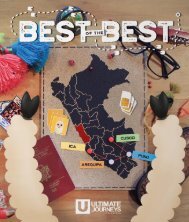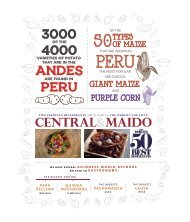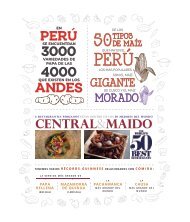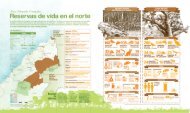UJ #17 - Traditional Peru
Create successful ePaper yourself
Turn your PDF publications into a flip-book with our unique Google optimized e-Paper software.
JUNE | INTI RAYMI<br />
Hundreds of actors<br />
dance during the<br />
presentation.<br />
Taking a walk through the streets of Cusco is to journey<br />
into <strong>Peru</strong>’s past. The marvels and mystery’s of our Inca<br />
heritage are present every step of the way - not only<br />
in the language and culture, but also in the impressive<br />
stone architecture, where every giant rock seems to fit<br />
seamlessly into the other and structures remain sound<br />
and awe-inspiring 500 years later.<br />
Interestingly, the same can be said for our Colonial<br />
legacy, with the numerous, breath taking churches,<br />
convents, and all the incredible art pieces from the<br />
Cusco School of Art that decorate the walls of hotels,<br />
temples, and buildings to this day. Both these fascinating<br />
and equally important aspects of our past come together<br />
in the imperial city of Cusco, making it one of the most<br />
unique and magical places in the world.<br />
Much like our Inca and Spanish cultural heritage come<br />
together, so do local traditions and celebrations. While each<br />
small, native community might uphold specific festivities<br />
exclusive to them, there is one regional celebration<br />
that is honoured by all in the same way it was during<br />
Tahuantinsuyo: Inti Raymi, the celebration of the Sun.<br />
Each 24th of June, the day of the winter solstice, Cusco<br />
comes to a halt. The Main Square fills with locals and<br />
tourists alike who gather to witness and enjoy a<br />
recreation of the most important celebration held<br />
during the Inca reign. <strong>Traditional</strong>ly on this day, the Inca<br />
– as a son of the Sun – would praise and thank this deity<br />
for all it provides, requesting its continued protection<br />
and favour. With this God on their side, the Incas could<br />
confidently begin an auspicious New Year.<br />
Huacaypata – where the current Main Square is located<br />
– was the original setting for this celebration, receiving<br />
all the highest ranking members of the Inca Empire:<br />
the chiefs and military and administrative leaders from<br />
LimaTours<br />
LimaTours<br />
The Sacsayhuaman<br />
esplanade is full<br />
of people during<br />
the Inti Raymi<br />
celebration.<br />
THE RE-ENACTMENT OF THE INTI RAYMI<br />
FESTIVAL HAS BEEN CONSIDERED<br />
A “NATIONAL CULTURAL HERITAGE<br />
AND A MAIN NATIONAL IDENTITY<br />
CEREMONIAL RITUAL” BY THE PERUVIAN<br />
GOVERNMENT SINCE 2001.<br />
the four suyos, or corners of the empire. Thousands of<br />
people would make the pilgrimage to Cusco, preparing<br />
both physically and spiritually for this important event.<br />
Some historic accounts claim that attendees would fast<br />
for days before the ceremony, purifying their bodies<br />
before the 9-15 day celebration.<br />
The Inca arrives<br />
at the Plaza de<br />
Armas on his<br />
plinth. Around<br />
him, soldiers<br />
and servants<br />
kneel.<br />
42

















